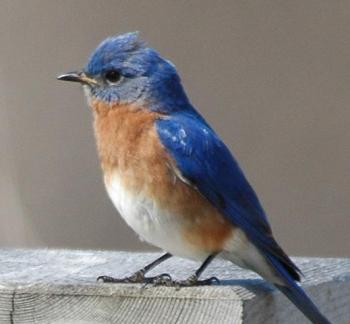Along the Bluebird Trail

Eastern Bluebird
Photo credit: Jim Williams
by Val Cunningham
Contributing Writer
Humans are helping the robin’s beautiful cousin, once a rare sight, make an astounding comeback.
My bluebird season started on the last day in March, as I hiked around Como Park’s golf course, making sure all the sturdy cedar nest boxes were firmly mounted on their poles and ready for occupancy after the long winter.
The season ended four and a half months later, during the second week in August, when I cleaned out the last bedraggled clump of nesting material from one of the 15 boxes that make up my bluebird trail.
In between lay a summer of encouraging these beautiful blue thrushes to set up housekeeping by walking the trail each week, checking that weather and predators were being kept out, making minor repairs and booting out house sparrows whenever they took up residence.
Success doesn’t always come easy on my trail, with sparrows and occasional vandalism causing some nests to fail. But a total of 35 young bluebirds flew out of their nest structures and joined their parents in the big wide world over the summer. And the nearby bluebird trail within Como Park produced 42 young bluebirds, for a total of 77 for the park as a whole.
Many of your fellow Minnesotans volunteer as bluebird trail monitors each year. In 2009, more than 500 volunteers in the official Minnesota Bluebird Recovery Program reported nearly 21,000 newly minted young bluebirds emerging from nest boxes around the state.
“And that’s probably just the tip of the iceberg,” says Carrol Henderson, who directs the Department of Natural Resources’ Nongame Wildlife Program. “There easily could have been 100,000 to 150,000 new bluebirds fledged in 2009,” since many people set up and monitor nest boxes but don’t get around to filling out data forms.
Whatever the number, it’s a vast improvement from 50 years ago, when a bluebird sighting was a rare thing. Some passionate individuals set out in the 1970s to change things, forming bluebird societies and encouraging volunteers to put up nest boxes and monitor trails. The DNR’s Nongame Program held workshops and. Henderson himself produced an excellent book, Woodworking for Wildlife, Homes for Birds and Animals. The recent third edition spells out everything you need to know to be a good host to bluebirds.
A couple questions
Won’t bluebirds abandon their nests if their box is opened each week to check for signs of trouble? The answer is no, the birds are momentarily disturbed but quickly fly back in to tend eggs or nestlings.
How do other birds know that the nest boxes are intended for bluebirds? They don’t: various species of birds, such as tree swallows, wrens and chickadees, frequently adopt bluebird houses, and that’s just fine with us monitors. The one bird we won’t tolerate is the house sparrow, since this is a non-native species that attacks bluebirds, even kills them, to take over a box. (Sparrows are one of the reasons the small thrush’s numbers plummeted in the last century.)
Why place the nest boxes on a golf course? It turns out that golf courses (and cemeteries) offer ideal habitat for bluebirds—open areas with short grass that allow the birds to easily hunt ground-scuttling beetles and other insects.
As I walk in Como Park in early fall I can often hear the soft melodious song of a bluebird family talking to each other. Golfers are treated to the sight of bluebirds flitting from ground to nest box to feed the youngsters. Yes, bluebirds have come back from a time when their numbers got dangerously low.
It’s much more likely, these days, that you might spot a flash of brilliant blue and know you’re seeing a bird with a big fan club that’s continuing to bound back from the brink.
St. Paul, Minnesota resident Val Cunningham leads bird hikes for the St. Paul Audubon Society and writes about nature for local, regional and national publications.



